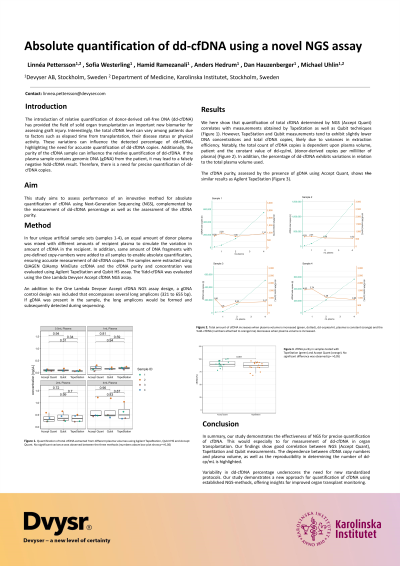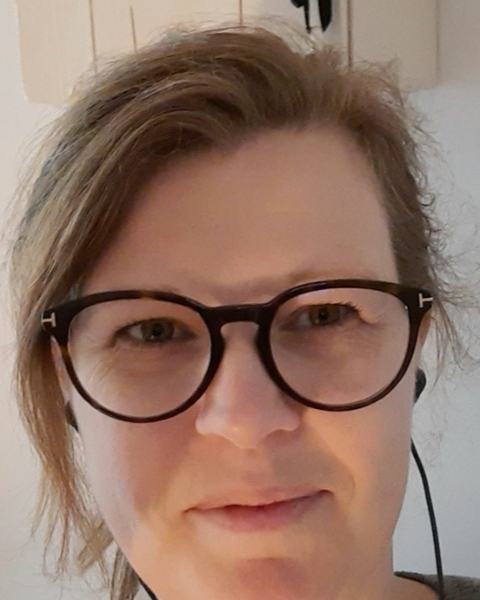Back

(P704) Absolute quantification of dd-cfDNA using a novel NGS assay
Location: Platinum Ballroom

Poster Presenter(s)
Aim: With the introduction of relative quantification of donor-derived cell-free DNA (dd-cfDNA), solid organ transplantation has been offered an important new biomarker for graft injury The fact that the total cfDNA level varies in patients, caused among other things by their general health, which can affect the percentage of dd-cfDNA detected, there is a need for accurate quantification of dd-cfDNA copies. This study aims to introduce an innovative method for absolute quantification of cfDNA using Next-Generation Sequencing (NGS), complemented by the assessment of dd-cfDNA percentage.
Method: An equal amount of donor plasma was mixed with different amounts of recipient plasma to simulate the variation in amount of cfDNA in the recipient. In addition, synthetic DNA fragments with pre-defined copy-numbers were added to enable absolute quantification, ensuring accurate measurement of dd-cfDNA copies. The samples were extracted using QIAGEN QIAamp MinElute ccfDNA and the cfDNA purity and concentration was evaluated using Agilent TapeStation and Qubit HS assay. The %dd-cfDNA was evaluated using One Lambda Devyser Accept cfDNA NGS assay.
Results: We here show that the overall quantity of cfDNA determined by NGS correlates with measurements obtained through both TapeStation and Qubit techniques. However, TapeStation and Qubit measurements tend to exhibit slightly lower DNA concentrations and total cfDNA copies, likely attributable to variances in extraction efficiency. Notably, the total count of cfDNA copies is dependent upon both plasma volume and the constant value of dd-cp/mL (donor-derived copies per milliliter of plasma). In addition, the percentage of dd-cfDNA exhibits variations in relation to the total plasma volume used.
Conclusion: In summary, our study demonstrates the effectiveness of NGS for precise quantification of cfDNA, especially dd-cfDNA in organ transplantation. Our findings show good correlation between NGS, TapeStation, and Qubit measurements. We highlight the dependence between cfDNA copy numbers and plasma volume and the reproducibility in determining the number of dd-cp/mL. Variability in dd-cfDNA percentage underscores the need for new standardized protocols. Our study demonstrates a new approach for quantification of cfDNA using established NGS-method, offering insights for improved organ transplant monitoring.
Method: An equal amount of donor plasma was mixed with different amounts of recipient plasma to simulate the variation in amount of cfDNA in the recipient. In addition, synthetic DNA fragments with pre-defined copy-numbers were added to enable absolute quantification, ensuring accurate measurement of dd-cfDNA copies. The samples were extracted using QIAGEN QIAamp MinElute ccfDNA and the cfDNA purity and concentration was evaluated using Agilent TapeStation and Qubit HS assay. The %dd-cfDNA was evaluated using One Lambda Devyser Accept cfDNA NGS assay.
Results: We here show that the overall quantity of cfDNA determined by NGS correlates with measurements obtained through both TapeStation and Qubit techniques. However, TapeStation and Qubit measurements tend to exhibit slightly lower DNA concentrations and total cfDNA copies, likely attributable to variances in extraction efficiency. Notably, the total count of cfDNA copies is dependent upon both plasma volume and the constant value of dd-cp/mL (donor-derived copies per milliliter of plasma). In addition, the percentage of dd-cfDNA exhibits variations in relation to the total plasma volume used.
Conclusion: In summary, our study demonstrates the effectiveness of NGS for precise quantification of cfDNA, especially dd-cfDNA in organ transplantation. Our findings show good correlation between NGS, TapeStation, and Qubit measurements. We highlight the dependence between cfDNA copy numbers and plasma volume and the reproducibility in determining the number of dd-cp/mL. Variability in dd-cfDNA percentage underscores the need for new standardized protocols. Our study demonstrates a new approach for quantification of cfDNA using established NGS-method, offering insights for improved organ transplant monitoring.

